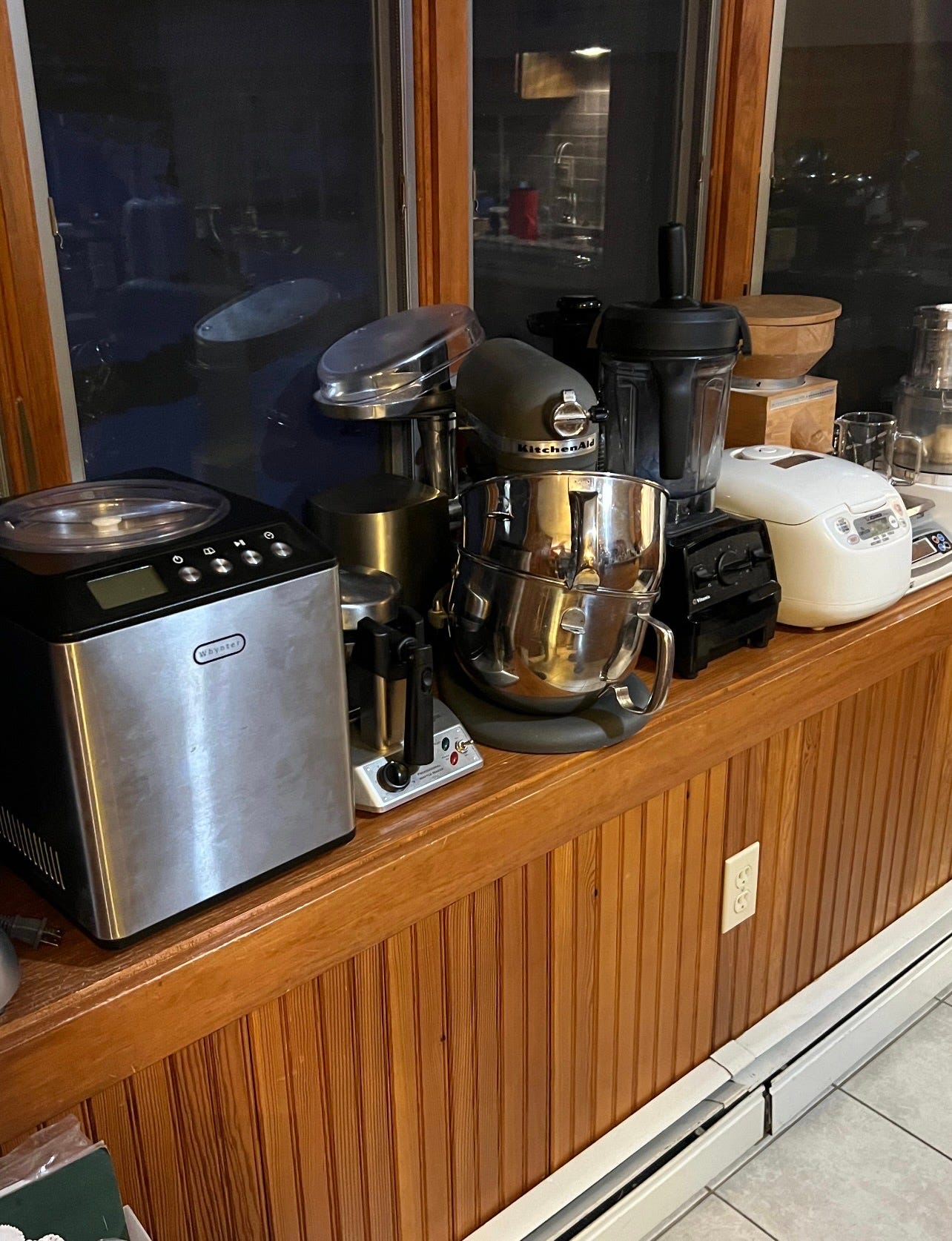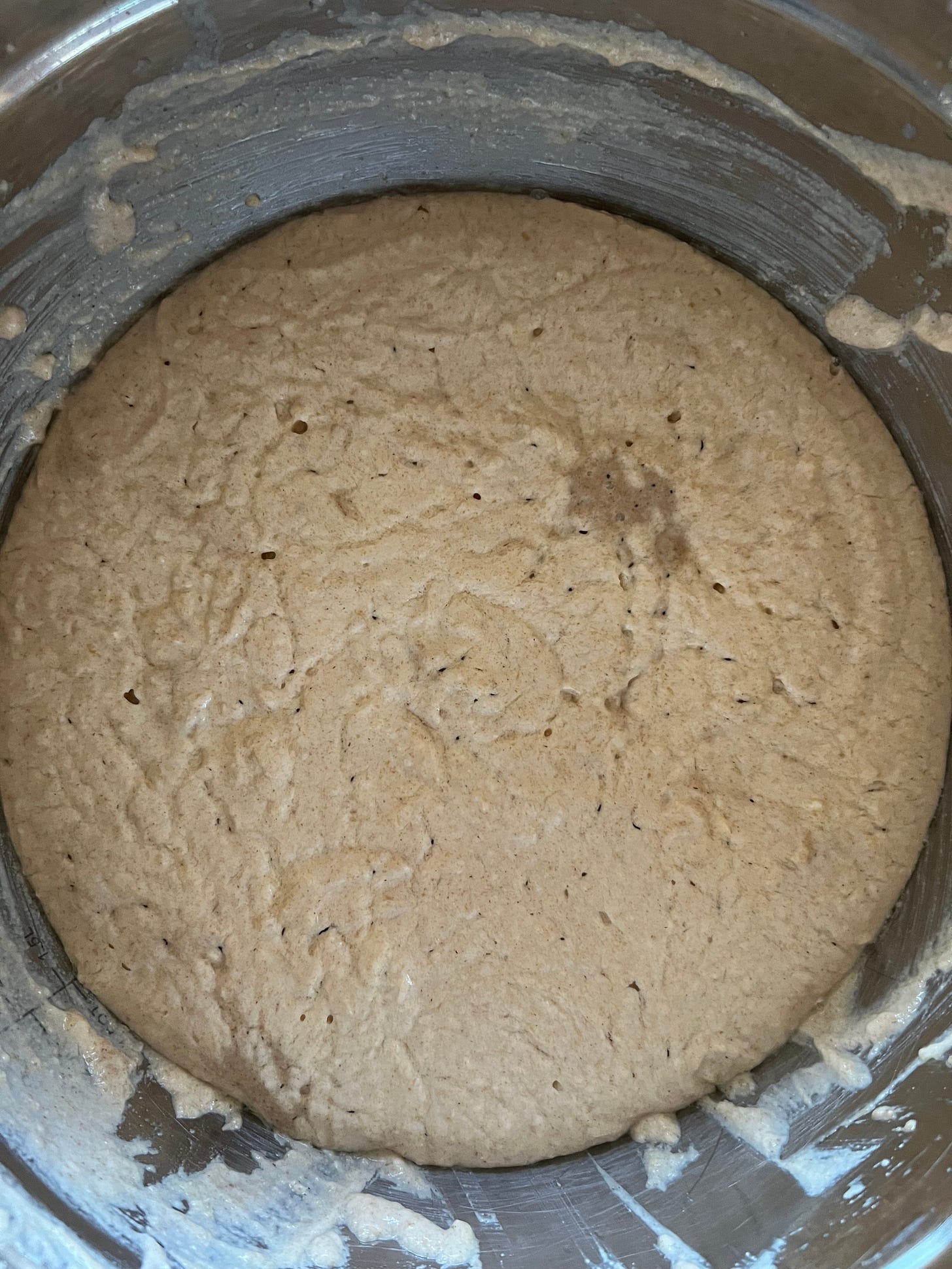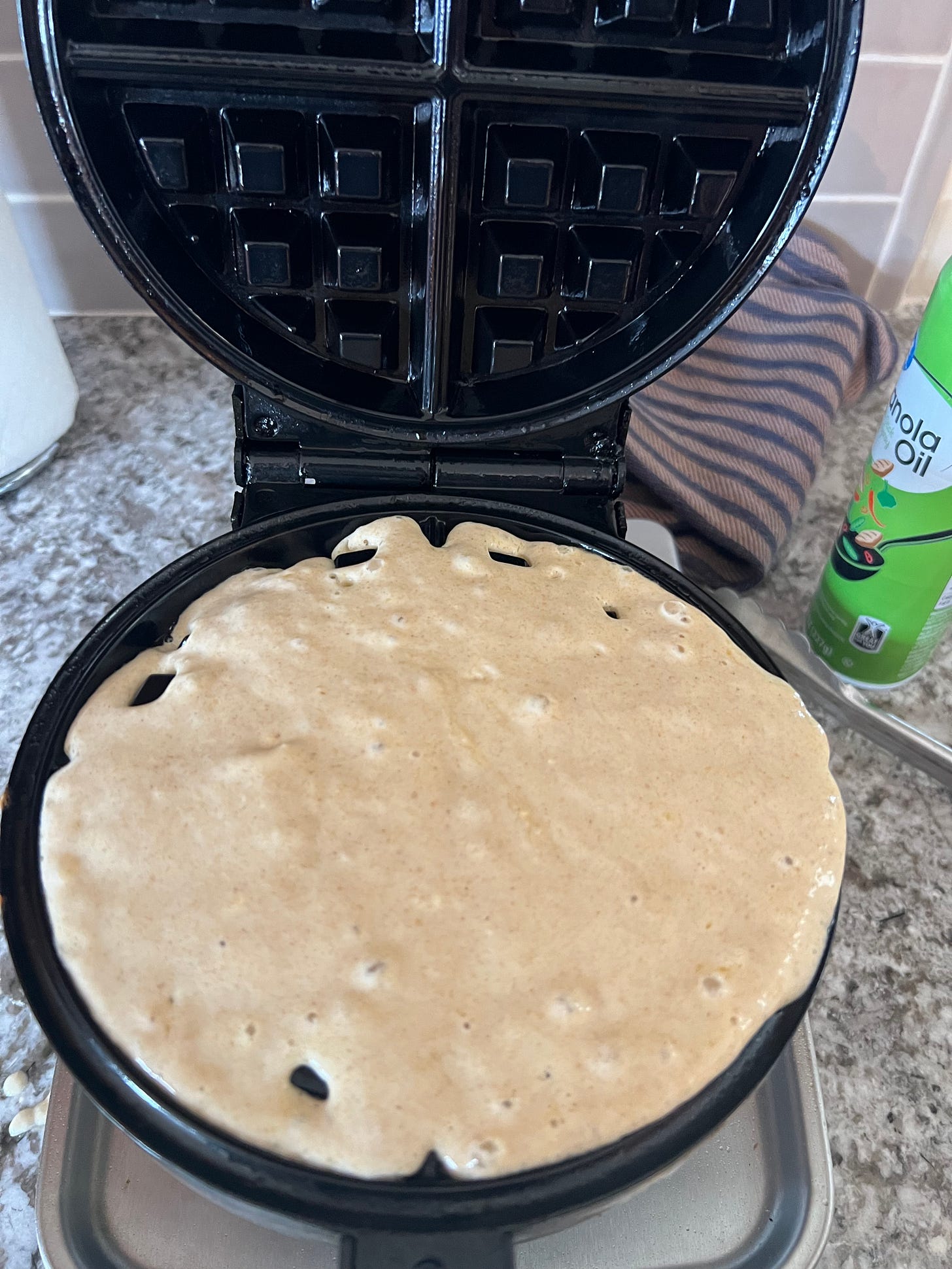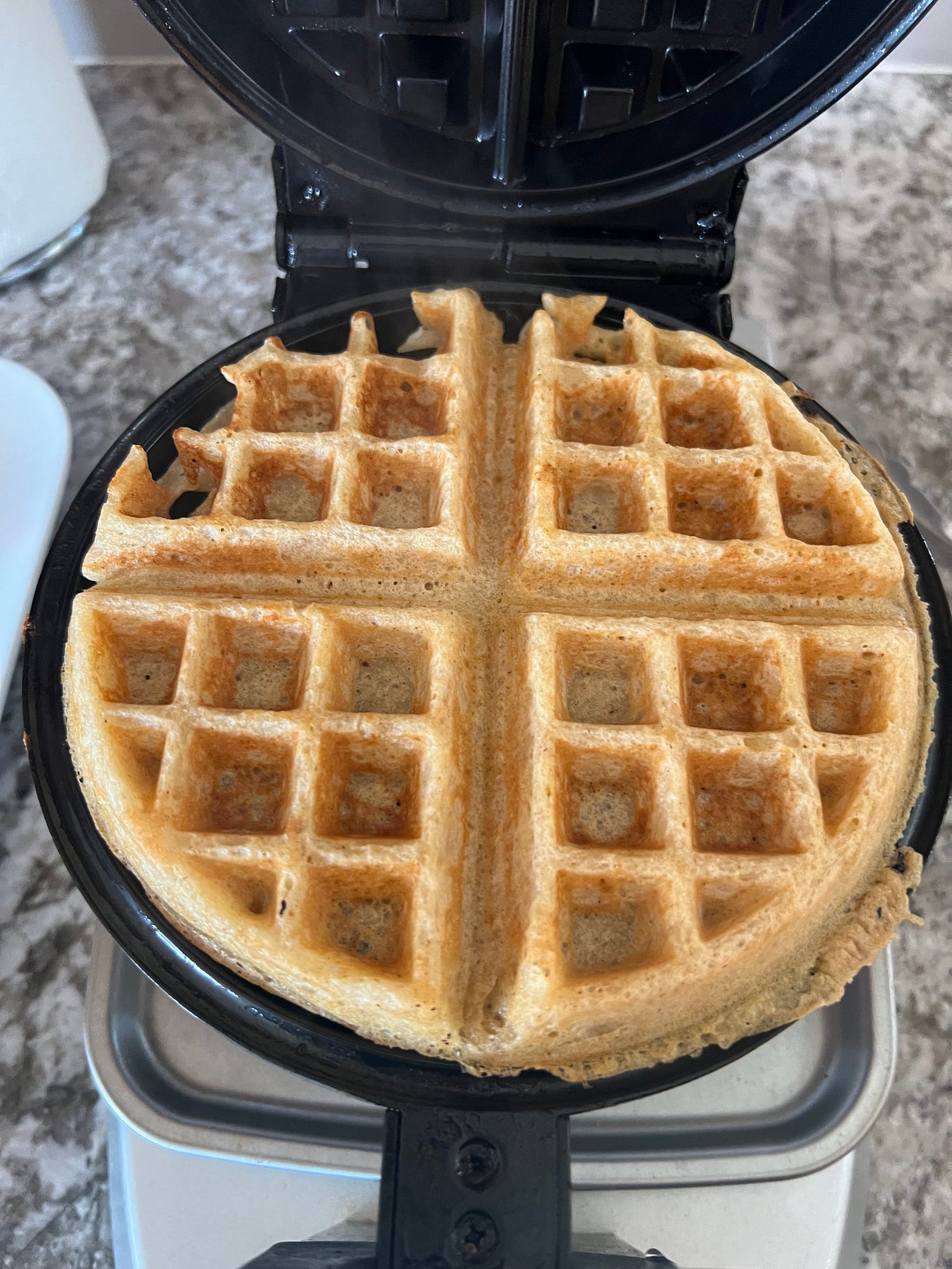Issue #143: Time for Waffles
Unpacking Continues, Chaos Prevails, I Can See My Waffle Maker, Yeast-Raised Waffles with and without Sourdough
We’ve made progress in New Hampshire. More than 100 boxes have been emptied, collapsed, and taken to the cardboard recycling pile at the nearby dump. There are probably more than 100 to go. Just when I managed to find a place for everything I brought from my old kitchen in the new, the painters came and took apart the cabinets. Chaos prevails.
It is really hard to believe how much storage space we had in our Manhattan apartment. The amount of food and dishes and cookware and appliances I brought with us is staggering to see here in this country house that’s more than twice the size.
I’ve decided to use a large but inconveniently placed bay window in the kitchen as a staging area for my appliances in the hopes that easy access will encourage more regular use. Although we had all that storage space in Gramercy, access to the Huron juicer or my electric meat grinder required the skill of a pro Jenga player.
Similarly out of regular reach in Manhattan was my professional Waring Belgian waffle iron. Though I’ve written about Nate’s pancake proclivities, he likes a good waffle, too. While we were in Belgium last year I wrote about my beloved gaufres de Liège, the small, dense, crunchy, chewy waffles originating in the city of Liège but sold on the streets of many Belgian towns (see Issue #97).
The Belgian waffles that became popular at brunches in the U.S. in the 1970s are technically gaufres de Bruxelles, that is, “Brussels waffles.” Lighter and airier than their Liègeois cousins, Brussels waffles are made with a batter more similar to pancakes. They became popular here after the 1964-5 World’s Fair, where a Belgian entrepreneur’s kiosk required ten staff just to slice strawberries.
There are many different versions of Belgian waffles these days. All they really have in common with the original is that they are made in a large, round, deeply dimpled Belgian waffle iron. The goal is to get the waffles crisp, light, and flavorful. There are plenty of variables and most people have a theory about what makes a waffle sing. For crispiness, some suggest a high proportion of sugar, others a high proportion of fat, still others a very hot iron. Cornmeal is a popular textural addition. For lightness, you’ll see some recipes require you to beat the egg whites and fold them in. A few suggest alternate gluten-free flours, such as rice. To add flavor, you’ll see buttermilk, sour cream, and yeast. In the morning, I’m looking for the simplest solution.
Marion Cunningham, better known as the new, now late, Fannie Farmer, was famous for her yeast-raised waffles. An invitation to her house for waffles meant you had been accepted into the food writers’ pantheon. (I was never invited.)
And then there is sourdough. Along the same lines of yeast and fermented dairy products like buttermilk, sourdough is a yeasty, fermented paste of flour and water that contributes to all three of the best waffle qualities: crispness, lightness, and taste.
For my first waffle in the new house (made in my readily accessible waffle iron), I chose a sourdough recipe based on one perfected by the OCD sourdough specialist Maurizio Leo, who writes The Perfect Loaf. (Don't worry, you can make delicious waffles without sourdough if you don’t have any discard around. See below.) Because of recent distractions—such as, two weeks in India and our move to the country—I’ve got quarts of sourdough discard in the fridge waiting to be made into something. These waffles seemed perfect.
If you have sourdough discard these waffles are simple to make. Like Cunningham’s yeast waffles, they need to be started the night before. But then in the morning all you have to do is finish mixing in a few ingredients, preheat your waffle iron, and you are ready for breakfast.
My sourdough starter is made with 100% whole-grain rye, so it has both good flavor and density, but a slight pasty quality. To lighten and crisp the waffles, I substituted some rice flour for the all-purpose. Otherwise, I did what Maurizio told me to do, and the results were superb. That’s why I’m sharing the recipe with you here.
RECIPE: Sourdough Waffles
Yields 6 large waffles
460g (2 cups) low-fat buttermilk
86g (6 tablespoons) unsalted butter, melted and cooled
100g (1/2 cup) ripe sourdough starter
2 teaspoons sugar
175g (about 1 1/3 cups) all-purpose flour
75g (about 2/3 cup) rice flour
1 teaspoon fine sea salt
1/2 teaspoon baking soda
2 eggs, beaten
The night before, in a large bowl, whisk together the buttermilk and melted butter. Add the sourdough starter and whisk thoroughly. Whisk in the sugar and flour to incorporate. Cover and let sit at room temperature overnight for at least 10 hours. Come morning, it should have bubbled and risen.
In the morning, preheat your waffle iron or maker. To the fermented batter add the salt, baking soda, and beaten egg, just until combined.
Spray your preheated iron with nonstick pan spray and ladle in about a cup of batter. Close and cook according to directions. I like my waffles well-done and crisp, about 4 1/2 to 5 minutes in my machine. If you are making a full batch of waffles for breakfast, keep cooked waffles warm on a rack in a 250°F. oven while you finish making the rest.
And if you don’t have any sourdough starter on hand, don’t fret. Marion Cunningham’s classic yeast waffle recipe is easy and produces similarly delicious results. I’ve adapted it for instant yeast.
RECIPE: Marion Cunningham’s Yeast-Raised Waffles
Yields 6 large waffles
2 teaspoons instant yeast
2 1/4 cups whole milk
1/2 cup (1 stick) unsalted butter, melted and cooled
1 teaspoon kosher salt
1 teaspoon sugar
2 cups all-purpose flour
2 large eggs, beaten
1/4 teaspoon baking soda
In a large bowl, combine the yeast, milk, melted butter, salt, sugar, and flour, and whisk together until smooth. Cover and let sit on the counter overnight. In the morning, preheat the waffle iron. Stir in the beaten eggs and baking soda until blended. Cook the waffles as described above.










And don’t forget James Beard’s sour cream pancake/waffle recipe, also delicious, no yeast or starter needed